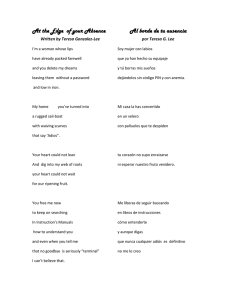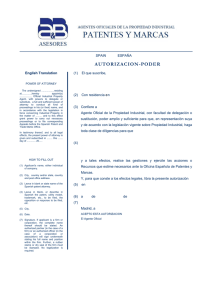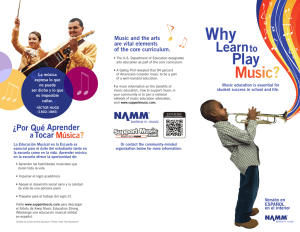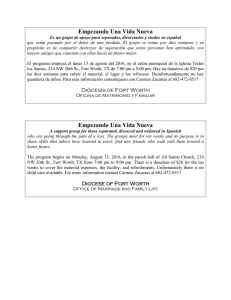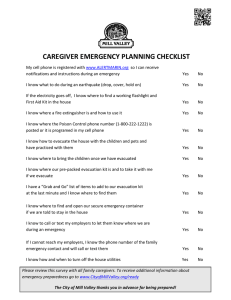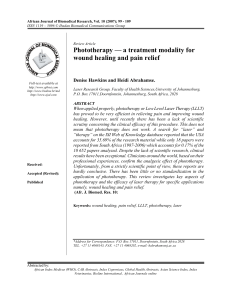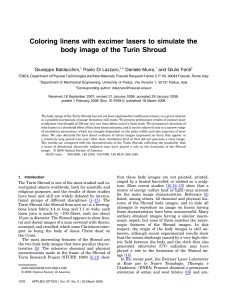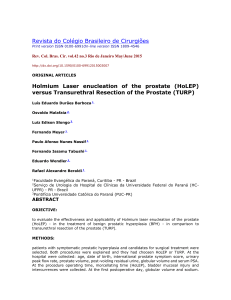PE576S Laser Treatment for Skin- Spanish
Anuncio
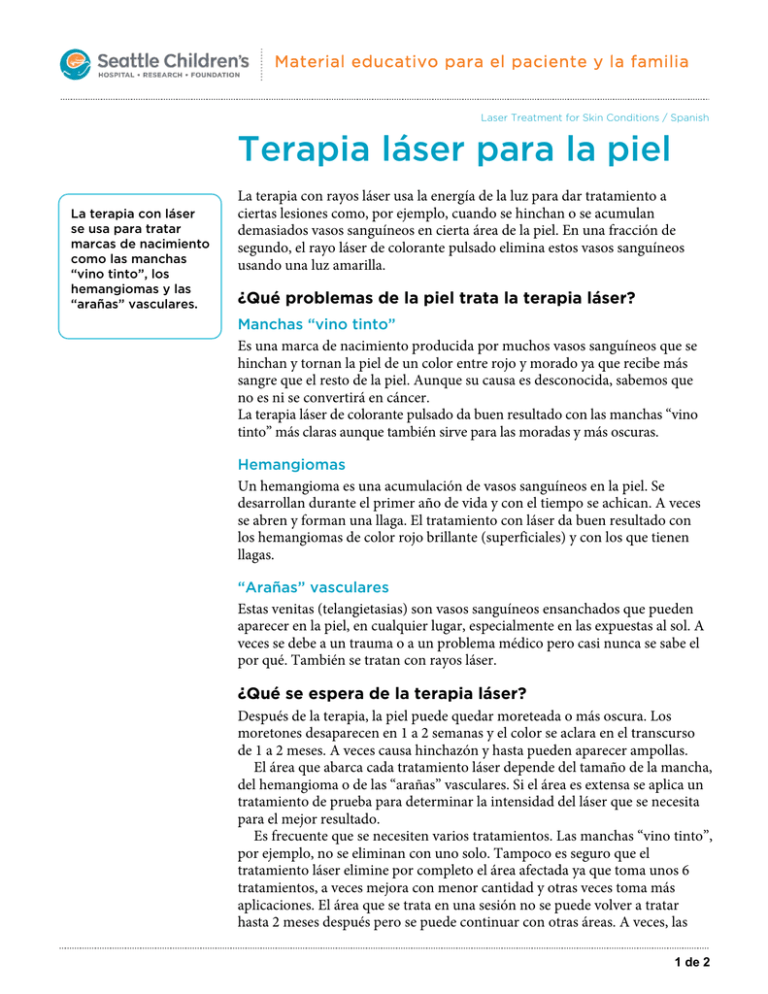
Material educativo para el paciente y la familia Laser Treatment for Skin Conditions / Spanish Terapia láser para la piel La terapia con láser se usa para tratar marcas de nacimiento como las manchas “vino tinto”, los hemangiomas y las “arañas” vasculares. La terapia con rayos láser usa la energía de la luz para dar tratamiento a ciertas lesiones como, por ejemplo, cuando se hinchan o se acumulan demasiados vasos sanguíneos en cierta área de la piel. En una fracción de segundo, el rayo láser de colorante pulsado elimina estos vasos sanguíneos usando una luz amarilla. ¿Qué problemas de la piel trata la terapia láser? Manchas “vino tinto” Es una marca de nacimiento producida por muchos vasos sanguíneos que se hinchan y tornan la piel de un color entre rojo y morado ya que recibe más sangre que el resto de la piel. Aunque su causa es desconocida, sabemos que no es ni se convertirá en cáncer. La terapia láser de colorante pulsado da buen resultado con las manchas “vino tinto” más claras aunque también sirve para las moradas y más oscuras. Hemangiomas Un hemangioma es una acumulación de vasos sanguíneos en la piel. Se desarrollan durante el primer año de vida y con el tiempo se achican. A veces se abren y forman una llaga. El tratamiento con láser da buen resultado con los hemangiomas de color rojo brillante (superficiales) y con los que tienen llagas. “Arañas” vasculares Estas venitas (telangietasias) son vasos sanguíneos ensanchados que pueden aparecer en la piel, en cualquier lugar, especialmente en las expuestas al sol. A veces se debe a un trauma o a un problema médico pero casi nunca se sabe el por qué. También se tratan con rayos láser. ¿Qué se espera de la terapia láser? Después de la terapia, la piel puede quedar moreteada o más oscura. Los moretones desaparecen en 1 a 2 semanas y el color se aclara en el transcurso de 1 a 2 meses. A veces causa hinchazón y hasta pueden aparecer ampollas. El área que abarca cada tratamiento láser depende del tamaño de la mancha, del hemangioma o de las “arañas” vasculares. Si el área es extensa se aplica un tratamiento de prueba para determinar la intensidad del láser que se necesita para el mejor resultado. Es frecuente que se necesiten varios tratamientos. Las manchas “vino tinto”, por ejemplo, no se eliminan con uno solo. Tampoco es seguro que el tratamiento láser elimine por completo el área afectada ya que toma unos 6 tratamientos, a veces mejora con menor cantidad y otras veces toma más aplicaciones. El área que se trata en una sesión no se puede volver a tratar hasta 2 meses después pero se puede continuar con otras áreas. A veces, las 1 de 2 Terapia láser para la piel Para más información • Dermatología 206-987-2158 • Anomalías Vasculares 206-987-4606 • El proveedor de atención médica de su niño. • www.seattlechildrens.org Servicio gratis de interpretación • Estando en el hospital, solicítelo con la enfermera de su niño. • Fuera del hospital, llame a nuestra línea gratis de interpretación 1-866-583-1527. Menciónele al intérprete el nombre de la persona o extensión que necesita. • Para personas sordas y con problemas de audición marque el 206-987-2280 (TTY). manchas vino tinto vuelven a oscurecerse con el tiempo y requieren más tratamientos (a veces 1 o 2 veces al año) para evitarlo. ¿Cuáles son los riesgos de la terapia láser? El riesgo de que quede una cicatriz es menor al 1%. El rayo láser de colorante pulsado puede causar que la piel se oscurezca un poco debido a la hemoglobina que se escapa al destruirse los vasos sanguíneos, lo que tiende a desaparecer en pocos meses. A veces el área tratada se ampolla, pierde la coloración y, aunque es raro, puede dejar una cicatriz como una pequeña marca en la piel. ¿Qué se siente durante la terapia láser? La mayoría de los pacientes sienten un breve ardor (como el golpe de una bandita elástica sobre la piel). Los niños casi siempre necesitan algún tipo de anestesia o sedante. En nuestra clínica usamos una crema entumecedora antes de tratar manchas vino tinto pequeñas, hemangiomas o “arañas” vasculares. Si la lesión es extensa se hace en la sala de operaciones con anestesia general. Tomamos la decisión junto a los padres para decidir cuál es la mejor opción para su niño. ¿Dónde se hace la terapia láser? La terapia quirúrgica ambulatoria con láser se hace en la Clínica de Bellevue que pertenece al hospital Seattle Children’s. Si el tratamiento láser requiere anestesia general se hace en la sede principal del hospital en Seattle. ¿El seguro médico cubre el tratamiento? Depende de su seguro médico. Generalmente, las compañías evalúan si el tratamiento para una mancha vino tinto o una anormalidad vascular es por causa médica o solo un procedimiento de tipo estético. Si se determina una razón médica casi siempre lo cubren pero, si es de tipo estético, puede que no. Para decidir, las compañías de seguro analizan: • El tamaño de la lesión • Si afecta las actividades diarias del niño (su funcionamiento) • Qué riesgos existen si no se hace el tratamiento Si es de tipo estético y usted tiene que pagar porque su seguro no lo cubre, Children’s le ofrece un 25 % de descuento. Si le preocupa el costo del tratamiento, en Seattle Children’s tenemos un programa de asistencia financiera. Para completar una solicitud visite “Information for Patients and Families” (“Información para el paciente y la familia”) en nuestro sitio www.seattlechildrens.org o llame a la Oficina de Asesoría Financiera Children’s al 206-987-3333 si tiene preguntas. Seattle Children’s ofrece servicios de interpretación gratuitos para pacientes, familiares y representantes legales sordos, con problemas de audición o con inglés limitado. Seattle Children’s tendrá esta información disponible en formatos alternativos bajo solicitud. Por favor llame al Centro de Recursos para las Familias al 206-987-2201. Este volante fue revisado por personal clínico de Seattle Children’s. Sin embargo, como las necesidades de su niño son únicas, antes de actuar o depender de esta información, por favor consulte con el proveedor de atención médica de su niño. © 2002, 2006, 2010, 2013 Seattle Children’s Hospital, Seattle, Washington. Todos los derechos reservados. Dermatología 8/13 Tr (lv/jw) PE576S 2 de 2 Patient and Family Education Laser Treatment for Skin Conditions Laser therapy is used to treat birthmarks such as port wine stains, hemangiomas and spider veins. Laser therapy is a treatment that uses light energy to treat growths and skin conditions. Some skin conditions involve having too many blood vessels or swollen blood vessels in one area. The pulsed dye laser uses yellow light to specifically destroy blood vessels in a fraction of a second. What skin conditions can be treated with laser therapy? Port wine stains A port wine stain is a birthmark in which an increased number of swollen blood vessels create a reddish purple discoloration of the skin. More blood flows through this skin and so it appears redder than the skin around it. It is not a cancer and does not turn into cancer. The cause is not known. Pulsed dye laser therapy works well for port wine stains. It works better for lighter ones than darker ones, but the darker purple marks can also be treated. Hemangiomas A hemangioma is a growth of blood vessels in the skin. Hemangiomas grow during the first year of life and then slowly shrink over time. They can sometimes break open, creating an ulceration. Laser treatment works well on the bright red (superficial) hemangiomas and hemangiomas with ulcerations. Spider veins Spider veins (telangiectasias) are enlarged blood vessels that can occur almost anywhere on the skin. They are common in areas of the skin that are exposed to the sun. They can occur as a result of injury or other medical problems. In most cases, they simply just occur and the cause is unknown. Laser treatment also works on spider veins. What can we expect with laser therapy? The laser often makes the area treated look bruised or darker after the treatment. This usually fades in 1 to 2 weeks, and then there will be gradual lightening of the area treated over the next 1 to 2 months. There may also be swelling or sometimes blisters after the treatment that can last for a few days. The area of the skin that can be treated by laser at any one time depends on the size of the port-wine stain, hemangioma or spider veins. For large lesions we will do a test treatment to decide what intensity of laser will give the best results. Multiple laser treatments are often needed. Port wine stains cannot be removed in just one treatment. There is no guarantee that laser treatments can completely clear affected areas. On average it takes about 6 treatments for each area treated. Some improve a lot after fewer treatments and some need more. We wait about 2 months between treatments on the same area. 1 of 2 Laser Treatment for Skin Conditions To Learn More • Dermatology 206-987-2158 • Vascular Anomalies Clinic 206-987-4606 • Ask your child’s healthcare provider • www.seattlechildrens.org However, untreated tissue next to these areas can be treated sooner. Port wine stains can sometimes darken again over time and may need repeat treatments (sometimes once or twice a year) to keep them as light as possible. What are the risks of laser treatment? The risk of scarring is less than 1 percent. The pulsed dye laser may cause a brownish discoloration of the skin. This comes from the hemoglobin released from destroyed blood vessels. This usually gets better with time and fades away within a few months. Sometimes the area treated can blister. Scars that look like tiny pits and loss of pigmentation can also happen, but these are very rare. How does laser treatment feel? Free Interpreter Services • In the hospital, ask your child’s nurse. • From outside the hospital, call the toll-free Family Interpreting Line 1-866-583-1527. Tell the interpreter the name or extension you need. • For Deaf and hard of hearing callers 206-987-2280 (TTY). Most patients say the laser feels like a brief sting (like an elastic band snapping against the skin). Children often need a form of anesthesia or sedation. We treat smaller port wine stains, hemangiomas and spider veins in the clinic using a numbing cream on the skin. Children with larger lesions often need to be treated in the operating room under general anesthesia. We will talk with you to decide what is the best option for your child. Where is laser treatment done? Outpatient laser surgery is done at the Seattle Children’s Bellevue Clinic. The laser treatments done under general anesthesia are performed in the operating room at the main hospital in Seattle. Will laser treatment be covered by insurance? Having laser treatment covered by insurance depends on your insurance plan. Most insurance plans will assess the treatment of a port wine stain or vascular abnormality to see if it is medically necessary or a cosmetic procedure. If it is found to be medically necessary, it is often covered by insurance. If it is seen as a cosmetic procedure, it may not be covered. Insurance plans look at 3 things about the lesion to make this decision: • How big it is • Whether it affects your child’s ability to do everyday tasks (function) • The risks of not getting treatment For cosmetic treatments that you will be paying for, Children’s offers a 25 percent discount for services not covered at all by insurance. If you have concerns about costs for medically necessary procedures, Seattle Children’s financial assistance program may be helpful. Applications are on our Web site at www.seattlechildrens.org under “Information for Patients and Families.” Call Children’s Financial Counseling at 206-987-3333 with questions. Seattle Children’s offers interpreter services for Deaf, hard of hearing or non-English speaking patients, family members and legal representatives free of charge. Seattle Children’s will make this information available in alternate formats upon request. Call the Family Resource Center at 206-987-2201. This handout has been reviewed by clinical staff at Seattle Children’s. However, your child’s needs are unique. Before you act or rely upon this information, please talk with your child’s healthcare provider. © 2002, 2006, 2010, 2013 Seattle Children’s, Seattle, Washington. All rights reserved. Dermatology 8/13 PE576 2 of 2

